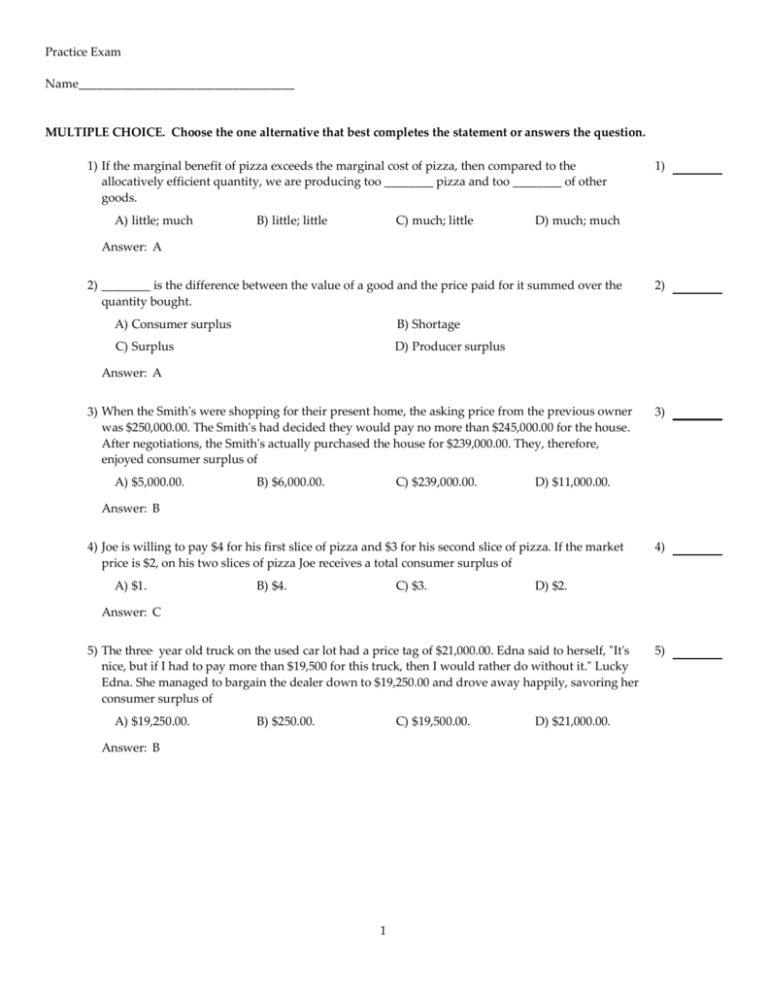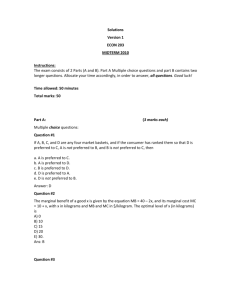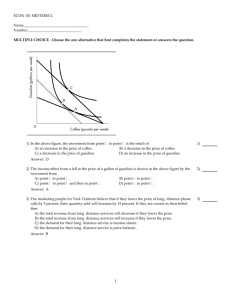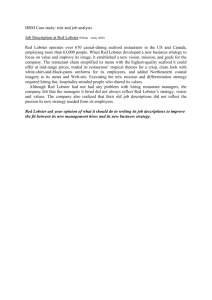Practice Exam Name___________________________________
advertisement

Practice Exam Name___________________________________ MULTIPLE CHOICE. Choose the one alternative that best completes the statement or answers the question. 1) If the marginal benefit of pizza exceeds the marginal cost of pizza, then compared to the allocatively efficient quantity, we are producing too ________ pizza and too ________ of other goods. A) little; much B) little; little C) much; little 1) D) much; much Answer: A 2) ________ is the difference between the value of a good and the price paid for it summed over the quantity bought. A) Consumer surplus B) Shortage C) Surplus D) Producer surplus 2) Answer: A 3) When the Smith's were shopping for their present home, the asking price from the previous owner was $250,000.00. The Smith's had decided they would pay no more than $245,000.00 for the house. After negotiations, the Smith's actually purchased the house for $239,000.00. They, therefore, enjoyed consumer surplus of A) $5,000.00. B) $6,000.00. C) $239,000.00. 3) D) $11,000.00. Answer: B 4) Joe is willing to pay $4 for his first slice of pizza and $3 for his second slice of pizza. If the market price is $2, on his two slices of pizza Joe receives a total consumer surplus of A) $1. B) $4. C) $3. 4) D) $2. Answer: C 5) The three-year old truck on the used car lot had a price tag of $21,000.00. Edna said to herself, "It's nice, but if I had to pay more than $19,500 for this truck, then I would rather do without it." Lucky Edna. She managed to bargain the dealer down to $19,250.00 and drove away happily, savoring her consumer surplus of A) $19,250.00. B) $250.00. C) $19,500.00. Answer: B 1 D) $21,000.00. 5) 6) The latest model car in the dealer's showroom has a sticker price of $35,000.00. Fred, the shopper has decided that he would pay no more than $32,000.00 for the car. After two hours of bargaining with the saleswoman, Fred actually purchases the car for $31,000.00. How much producer surplus did the dealer earn? 6) A) The amount of producer surplus cannot be determined from the information given. B) $1,000.00 C) $32,000.00 D) $31,000.00 Answer: A 7) Farmer Jones knows that the opportunity cost to produce a bushel of tomatoes is $5 per bushel. He also knows that a consumer is willing to pay a maximum of $9 for the bushel. The price of the bushel is $6 and Farmer Jones sells his bushel of $6. On this bushel, Farmer Jones earns a producer surplus equal to A) $1. B) $3. C) $6. 7) D) $5. Answer: A 8) Efficiency definitely has NOT been achieved if production is such that A) price is equal to marginal social cost. B) price is equal to marginal social benefit. C) marginal social benefit exceeds marginal social cost. D) All of the above answers are correct. Answer: C 2 8) 9) The figure above shows the market for coffee. If the efficient quantity of coffee is produced, the producer surplus is A) zero. B) $10 million. C) $60 million. 9) D) $20 million. Answer: D 10) In order to determine a household's budget line, you must know the A) prices of the goods bought, but not the household's income. B) prices of the goods bought and the household's income. C) household's income, but not the prices of goods bought. D) household's income, prices of the goods bought, and the household's preferences. Answer: B 3 10) 11) The figure above shows Tanya's consumption possibilities. Tanya spends $100 per month on movies and restaurant meals. The price of a movie ticket is ________ and the price of a restaurant meal is ________. A) $7; $15 B) $20; $5 C) $5; $20 11) D) $10; $10 Answer: C 12) The figure above shows Tanya's consumption possibilities. Which of the following combinations of goods is not affordable A) 12 movie tickets and 2 restaurant meals. B) 10 movie tickets and 3 restaurant meals. C) 6 movie tickets and 3 restaurant meals. D) 8 movie tickets and 3 restaurant meals. 12) Answer: B Price (dollars) 60 50 40 30 20 Quantity of tennis rackets demanded Jill Jed 1 0 2 0 2 1 3 2 4 3 13) Jill and Jed have individual demand curves for tennis rackets given in the table above and are the only two demanders in the market. What is the market quantity demanded at the price of $30? A) 11 B) 18 C) 5 Answer: C 4 D) 2 13) Price dollars per pound) Bart's quantity Lisa's quantity demanded demanded (pounds) (pounds) 2 3 4 5 9 7 4 1 5 4 2 0 Homer's quantity demanded (pounds) 7 6 5 3 14) Homer, Bart, and Lisa are the only consumers in the market. Using the information in the above table, what is the market demand for chocolate chip cookies at $4.00 per pound? A) 21 pounds B) 4 pounds C) 17 pounds 14) D) 11 pounds Answer: D 15) Ron spends $150 on movie tickets and pizza. The price of a pizza is $10 and a movie ticket is $7.50. If Ron buys 9 movie tickets how many pizzas can he afford? A) 8 B) 7 C) 10 15) D) 9 Answer: A 16) The slope of a budget line reflects 16) A) prices and income. B) the consumer's preference. C) the consumer's income. D) relative prices. Answer: D 17) If the relative price of pizza in terms of movies is 3, this means that 17) A) in terms of the dollars that must be spent to buy the product, pizza is more expensive than movies. B) 3 pizzas can be traded for 9 movies. C) the opportunity cost of a pizza is 3 movies. D) All of the above answers are correct. Answer: D 18) Suppose the price of chocolate chip cookies is $4.00 per pound and the price of a slice of cake is $2.00 per slice. The relative price of cookies in terms of cake is A) 1/2 slice of cake per cookie. B) $4.00 per cookie. C) 2 slices of cake per cookie. D) $2.00 per cookie. Answer: C 5 18) 19) Suppose that initially the price of a bag of jellybeans is $6, and the price of a bottle of Jolt cola is $2. If the price of a bottle of Jolt cola increases, then the relative price of jellybeans 19) A) increases. B) decreases. C) stays the same, but the relative price of Jolt cola decreases. D) stays the same, but the relative price of Jolt cola increases. Answer: B 20) The above figure shows Katie's consumption possibilities. The relative price of a movie ticket is A) 1 restaurant meal. B) 2 restaurant meals. C) 0.25 restaurant meals. D) 4 restaurant meals. Answer: C 6 20) 21) In the above figure, the budget line would rotate in the direction indicated as a result of a A) rise in the price of a book. B) a fall in the price of a movie. C) decrease in income. D) rise in the price of a movie. 21) Answer: D 22) If money income increases, a consumer's budget line 22) A) becomes flatter. B) shifts leftward and its slope does not change. C) shifts rightward and its slope does not change. D) becomes steeper. Answer: C 23) If Teddy's money income doubles and, at the same time, prices also double, then Teddy's budget line A) shifts leftward and its slope does not change. B) becomes steeper. C) shifts rightward and its slope does not change. D) does not change. Answer: D 7 23) 24) The figure above shows Sam's budget line. Which of the following combinations of gasoline and coffee are not available to Sam? A) 8 gallons of gasoline and 8 pounds of coffee B) 16 gallons of gasoline and 16 pounds of coffee C) 40 gallons of gasoline and 0 pounds of coffee D) 32 gallons of gasoline and 4 pounds of coffee Answer: B 8 24) 25) Lizzie's budget line is shown in the figure above. The relative price of a magazine is ________ per magazine. A) 0.5 of a cookie B) $1 C) 2 cookies 25) D) $2 Answer: C 26) Lizzie's budget line is shown in the figure above. The relative price of a cookie is ________ per cookie. A) $2 B) $1 C) 2 magazines D) 0.5 of a magazine 26) Answer: D 27) Lizzie's budget line is shown in the figure above. Lizzie's real income in terms of magazines is ________ magazines A) 20 B) 15 C) 5 27) D) 10 Answer: D 28) Lizzie's budget line is shown in the figure above. If the price of a magazine falls, the budget line A) shifts leftward and its slope does not change. B) becomes flatter. C) shifts rightward and its slope does not change. D) becomes steeper. Answer: B 9 28) 29) Lizzie's budget line is shown in the figure above. If the price of a cookie falls, the budget line 29) A) becomes flatter. B) shifts rightward and its slope does not change. C) becomes steeper. D) shifts leftward and its slope does not change. Answer: C 30) Lizzie's budget line is shown in the figure above. If Lizzie's income increases, her budget line 30) A) shifts leftward and its slope does not change. B) becomes flatter. C) shifts rightward and its slope does not change. D) becomes steeper. Answer: C 31) In an indifference curve/budget line diagram, generally when the price of a good increases, the consumer purchases ________ of the good and moves to a ________ indifference curve. A) more; lower B) more; higher C) less; higher Answer: D 10 D) less; lower 31) 32) The above figure shows Sam's budget line and one of his indifference curves. What combination of coffee and gasoline will Sam select? 32) A) Combination b because it is on his budget line and on the highest attainable indifference curve. B) Combination a because that contains all the gasoline he needs and still has some coffee. C) Combination c because that contains all the coffee he needs and some gasoline. D) none of the above Answer: A 33) The effect of a change in price on the quantity bought, keeping the consumer on the same indifference curve, is called the A) income effect. B) substitution effect. C) real effect. D) price effect. 33) Answer: B 34) Sam's income for gasoline and coffee currently is $60 per week. If Sam's budget for gasoline and coffee increased from $60.00 to $70.00, Sam would experience A) only an income effect. B) an increase in the marginal rate of substitution of both gasoline for coffee and coffee for gasoline. C) only a substitution effect. D) none of the above Answer: A 11 34) 35) The substitution effect from a fall in the price of a gallon of gasoline is shown in the above figure by the movement from A) point A to point B. B) point B to point C. C) point A to point C. D) point A to point B and then to point C. 35) Answer: A 36) The income effect from a fall in the price of a gallon of gasoline is shown in the above figure by the movement from A) point B to point C. B) point A to point B and then to point C. C) point A to point B. D) point A to point C. 36) Answer: A 37) In the above figure, when the price of a gallon of gasoline falls, which points in the above figure are used to derive points on the consumer's demand curve for gasoline? A) points A and C B) points B and C C) points A, B, and C D) points A and B 37) Answer: A 38) In the above figure, the rise in the price of a gallon of gasoline that created the movement from point C to point A would be shown as a movement ________ along the demand curve for ________. A) upward; coffee B) downward; gasoline C) upward; gasoline D) downward; coffee Answer: C 12 38) 39) Jane spends her monthly dining-out budget of $300.00 on either steak or lobster dinners. Using the above figure, what is the price of a steak dinner? A) $10.00 B) $15.00 C) $30.00 39) D) $20.00 Answer: B 40) The above figure shows Jane's budget line and two of her indifference curves. Which of the following happens to Jane's budget line if there were a decrease in her monthly dining out budget? 40) A) It would shift leftward and not change its slope. B) It would bend away from the origin, becoming more concave. C) It would shift rightward and not change its slope. D) It would bend toward the origin, becoming more convex. Answer: A 41) The above figure shows Jane's budget line and two of her indifference curves. How many steak dinners will Jane purchase each month? A) 8 steak dinners B) 6 steak dinners C) 4 steak dinners D) 10 steak dinners 41) Answer: D 42) The above figure shows Jane's budget line and two of her indifference curves. How many lobster dinners will Jane purchase each month? A) 10 lobster dinners B) 8 lobster dinners C) 4 lobster dinners D) 5 lobster dinners Answer: D 13 42) 43) The above figure shows Jane's budget line and two of her indifference curves. Jane's marginal rate of substitution is 43) A) equal to the ratio of the price of a steak dinner to the price of a lobster dinner when she is at her best affordable point. B) the rate at which she would give up a lobster dinner for a steak dinner and consider herself just as well off. C) equal to 2 lobster dinners per steak dinner at her best affordable point. D) Both answers A and B are correct. Answer: D 44) The above figure shows Jane's budget line and two of her indifference curves. When Jane is consuming at her best affordable point, what is her marginal rate of substitution? A) 0.33 lobster dinners per steak dinner B) 2.0 lobster dinners per steak dinner C) 0.5 lobster dinners per steak dinner D) 1.0 lobster dinners per steak dinner 44) Answer: C 45) Consider the change in the price of a book depicted in the above figure. The original budget line is BC. The new budget line is BD. As a result of this price change, the substitution effect can be represented by a movement from A) point A to point E. B) point A to point F. C) point F to point G. D) point A to point G. Answer: A 14 45) 46) Consider the change in the price of a book depicted in the above figure. The original budget line is BC. The new budget line is BD. As a result of this price change, the income effect can be represented by a movement from A) point G to point A. B) point A to point F. C) point E to point F. D) point G to point F. 46) Answer: C 47) Opportunity cost differs from the costs measured by an accountant because opportunity cost includes all A) conventional depreciation. B) implicit costs. C) economic profit. D) profits. 47) Answer: B 48) If instead of working on his own as a consultant making $25,000, Joe takes a job at a bank, the $25,000 is A) a loss. B) a depreciation. C) an opportunity cost. D) an accounting profit. 48) Answer: C 49) Mr. Sweet opened a candy store. He rented a building for $30,000 a year. During the first year of operation, Sweet paid $40,000 to his employees, $10,000 for utilities, and $20,000 for goods he bought from other firms. His total revenue was $135,000. Sweet's best alternative to running this candy store is to work for Wal-Mart as a sales associate for $15,000 a year. What is Sweet's total opportunity cost? A) $115,000 B) $15,000 C) $135,000 49) D) $100,000 Answer: A 50) A firm pays its workers $10 per hour. This cost is an example of an A) opportunity cost. B) implicit cost. C) explicit cost. D) Both answers A and C are correct. 50) Answer: D 51) Explicit costs differ from implicit costs in that 51) A) explicit costs are paid in money, but implicit costs are often non-paid opportunity costs. B) explicit costs are more important than implicit costs. C) implicit costs always present while some firms do not have any explicit costs. D) explicit costs are what an accountant would consider costs and are usually less than implicit costs. Answer: A 15 52) Mr. Sweet opened a candy store. He rented a building for $30,000 a year. During the first year of operation, Sweet paid $40,000 to his employees, $10,000 for utilities, and $20,000 for goods he bought from other firms. His total revenue was $135,000. Sweet's best alternative to running this candy store is to work for Wal-Mart as a sales associate for $15,000 a year. What are Sweet's explicit costs? A) $100,000 B) $115,000 C) $15,000 52) D) $135,000 Answer: A 53) Mr. Sweet opened a candy store. He rented a building for $30,000 a year. During the first year of operation, Sweet paid $40,000 to his employees, $10,000 for utilities, and $20,000 for goods he bought from other firms. His total revenue was $135,000. Sweet's best alternative to running this candy store is to work for Wal-Mart as a sales associate for $15,000 a year. What is Sweet's economic profit? A) -$20,000 B) $20,000 C) $35,000 53) D) zero Answer: B 54) Marginal product is 54) A) total amount of output produced divided by price of the output. B) total amount of output produced divided by the quantity of labor employed. C) the increase in output that results from a one-unit increase in the quantity of labor employed with all other inputs remaining the same. D) total amount of output produced. Answer: C Pizza Hut Labor Total product (workers) (pizzas produced per hour) 0 0 1 5 2 9 3 12 4 14 5 15 55) Using the data in the above table, what is the marginal product of the third employee? A) 3 pizzas per hour B) 12 pizzas per hour C) 2 pizzas per hour D) 4 pizzas per hour Answer: A 16 55) Jefferson's Cleaners Labor Total product (workers) (suits cleaned per day) 0 0 1 12 2 26 3 46 4 60 5 73 6 84 7 94 8 102 9 109 56) Based on the above table, what is the marginal product of the 6th worker hired at Jefferson's Cleaners? A) 10 suits per day B) 14 suits per day C) 11 suits per day 56) D) 84 suits per day Answer: C Labor (workers per day) 0 1 2 3 4 5 Total product (pizzas per day) 0 10 25 37 45 50 57) Based on the production data for Pat's Pizza Parlor in the above table, which worker has the largest marginal product? A) Worker 4 B) Worker 2 C) Worker 1 57) D) Worker 3 Answer: B 58) The law of diminishing returns states that as a firm uses more of A) a variable input, with a given quantity of fixed inputs, the firm's marginal cost eventually decreases. B) a variable input, given the quantity of fixed inputs, the firm's average total cost will eventually decrease. C) a variable input, with a given quantity of fixed inputs, the marginal product of the variable input eventually decreases. D) all inputs, the marginal product of each of these inputs eventually decreases. Answer: C 17 58) 59) Total fixed cost 59) A) increases as output increases. B) initially decreases and then increases as output increases. C) decreases as output increases. D) does not change as output changes. Answer: D 60) Which type of cost is independent of the quantity produced? A) marginal cost B) total cost 60) C) average cost D) fixed cost Answer: D Labor (workers) 0 1 2 3 4 Output (bikes) 0 20 50 60 64 Total fixed costs (dollars) 200 Total variable cost (dollars) Total cost (dollars) 100 61) The table above gives costs at Jan's Bike Shop. Unfortunately, Jan's record keeping has been spotty. Each worker is paid $100 a day. Labor costs are the only variable costs of production. What is the total cost of producing 50 bikes? A) $100 B) $400 C) $200 61) D) $300 Answer: B 62) The table above gives costs at Jan's Bike Shop. Unfortunately, Jan's record keeping has been spotty. Each worker is paid $100 a day. Labor costs are the only variable costs of production. What is the total fixed cost associated with producing 64 bikes? A) $400 B) $500 C) $300 62) D) $200 Answer: D 63) The table above gives costs at Jan's Bike Shop. Unfortunately, Jan's record keeping has been spotty. Each worker is paid $100 a day. Labor costs are the only variable costs of production. What is the total variable cost associated with producing 60 bikes? A) $500 B) $200 C) $400 63) D) $300 Answer: D 64) Ernie's Earmuffs produces 200 earmuffs per year at a total cost of $2,000 and $400 of this cost is fixed. What is Ernie's average total cost? A) $12 B) $8 C) $10 Answer: C 18 D) $2 64) 65) Because of the law of diminishing returns, marginal cost 65) A) initially increases and then decreases as output increases. B) initially decreases and then does not change as output increases. C) increases constantly as output increases. D) decreases constantly as output increases. Answer: C Labor (workers) 0 1 2 3 4 5 6 7 8 9 10 Total product (books sold per hour) 0 10 24 40 58 73 83 87 89 90 90 66) The above table shows the total product schedule for the campus book store. If employees are paid $6 per hour and there are no other variable costs, then what is the marginal cost (MC) per book of increasing book sales from 83 to 87 books per hour? A) $2.07 B) $1.50 C) $6.00 66) D) $4.00 Answer: B 67) The above table shows the total product schedule for the campus book store. If each employee is paid $6 per hour, what is the average variable cost of selling 83 books per hour (assuming labor costs are the only variable costs of production)? A) $0.07 per book B) $0.43 per book C) $6.00 per book Answer: B 19 D) $2.30 per book 67)






